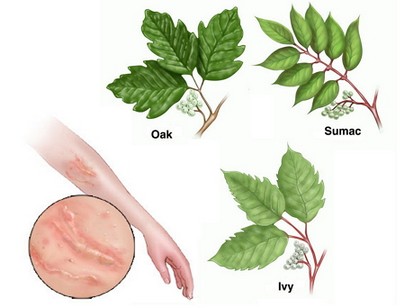Poison Ivy, Oak and Sumac in Children

Contents:
- Poison Ivy, Oak and Sumac in Children: Care Instructions
- Cause of the Rash
- Symptoms
- Diagnosis of Poison Ivy, Oak and Sumac
- Treatment
- Preventing an Allergic Reaction
Poison Ivy, Oak and Sumac in Children: Care Instructions
Poison ivy, oak, and sumac cause a red and very itchy rash (or contact dermatitis), which is shaped like streaks of blisters or swollen red patches of skin (hives). This is the most common skin condition that is caused by plants.
Cause of the Rash
This rash is caused by oil from poison ivy, oak and sumac plants. This oil can be found in any parts of the plants: leafs, branches, flowers, fruits and roots. The oil is a strong allergen that causes an allergic reaction in form of an itchy rash. Indirect contact can also cause a rash to occur, which happens when you touch clothes, pet fur, sport gear or garden tools that were in contact with the plant. However, this plant does not trigger an allergic reaction in everyone.
Symptoms
The main symptoms are:
- Itchy rash where the plant came in contact with the skin;
- Red streaks or patches where the plant came in contact with the skin;
- Blisters or swollen patches of skin (hives);
- Fluid-filled blisters.
Usually the rash occurs within 8-48 hours after contacting the plant, although it can also appear 5 hours or 15 days after the contact. If the allergy was obtained recently, the rash will occur within a week. It shows up in new spots during a few days, but only in areas of the skin that have been in contact with the plant.
The rash is not contagious, so one can’t catch the rash even after coming in contact with the blisters, because the poisonous oils are already absorbed by the skin or washed off. Sometimes it looks like the rash is spreading among children, but it usually is caused by an early contact with the blisters or objects that came in contact with the plants.
The more oil gets onto the skin, the more severe allergic reaction it will cause. A small amount of oil can trigger a very severe reaction in highly allergic individuals.
Severe symptoms include:
- Swollen face, mouth, neck, genitals or eyelids;
- Many weeping blisters.
Without any treatment the rash will persist for about 10-20 days. It can persist for up to 6 weeks in people with stronger allergy to the oil.
Diagnosis of Poison Ivy, Oak and Sumac
A doctor usually diagnoses poison ivy, oak, and sumac by checking the rash and asking a few questions about contacting a plant. If the patient didn’t come in direct contact with a plant, the doctor will ask questions about their occupation and hobbies.
Treatment
Most of the allergic reactions caused by poison ivy, oak, and sumac are easy to deal with at home. Use a cold wet cloth and have a cool bath. The symptoms can also be treated with over-the-counter antihistamines or calamine lotion. Seek a doctor’s advice for a moderate or strong allergic reaction. In this case a doctor might prescribe corticosteroids, creams, balms and injections.
Preventing an Allergic Reaction
The best way to avoid an allergic reaction is to learn to identify the plants and avoid any contact. If you can’t avoid contacting the plant, wear a long-sleeved clothing and use creams and lotions that protect from the poisonous oil.